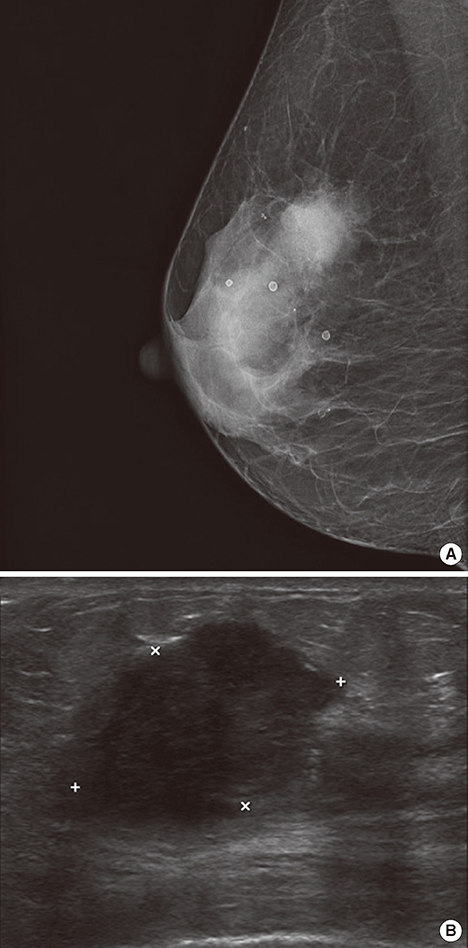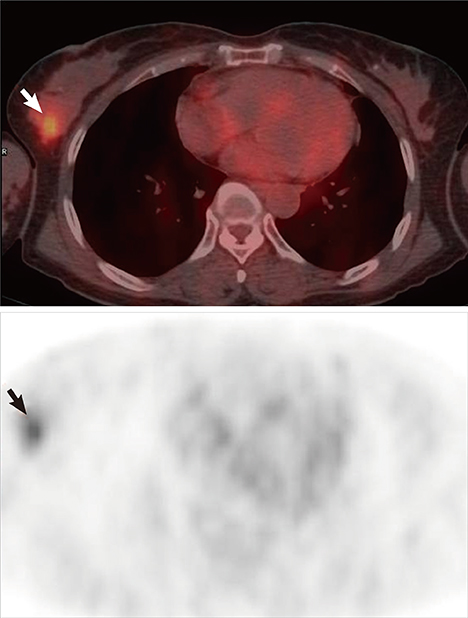J Breast Cancer.
2013 Sep;16(3):349-353. 10.4048/jbc.2013.16.3.349.
Breast Carcinoma with Choriocarcinomatous Features: A Case Report
- Affiliations
-
- 1Department of Pathology, Catholic University of Daegu School of Medicine, Daegu, Korea. ap510@cu.ac.kr
- 2Department of Pathology, Goodsamaritan Hospital, Pohang, Korea.
- 3Department of Nuclear Medicine, Catholic University of Daegu School of Medicine, Daegu, Korea.
- 4Department of Breast and Thyroid Surgery, Catholic University of Daegu School of Medicine, Daegu, Korea.
- KMID: 2286389
- DOI: http://doi.org/10.4048/jbc.2013.16.3.349
Abstract
- Nongestational choriocarcinoma differentiation is extremely rare in breast neoplasms. It is characterized by tumor cells similar to chorionic trophoblastic cells, which react with human placental lactogen and human chorionic gonadotropin (hCG). A 56-year-old woman presented with a palpable right breast mass without past history of trophoblastic tumors. An F-18 fluorodeoxyglucose (FDG) positron emission tomography/computed tomography (PET/CT) scan revealed one focus with low accumulation of FDG in the right breast (maximum standardized uptake value, 1.98). The patient underwent a right mastectomy and biopsy of sentinel nodes. Microscopically, the tumor was a typical invasive ductal carcinoma with multiple foci of choriocarcinoma features. Immunohistochemistry showed that the tumor cells resembling choriocarcinoma were positive for hCG antibody, but negative for HER2/neu, estrogen receptor, and progesterone receptor. A pathologic diagnosis of breast carcinoma with choriocarcinomatous features was made. To our knowledge, this is the first report of invasive carcinoma with choriocarcinomatous features and an unusual finding of low accumulation in an F-18 FDG PET/CT scan in Korea.
MeSH Terms
-
Biopsy
Breast
Breast Neoplasms
Carcinoma, Ductal
Choriocarcinoma
Chorion
Chorionic Gonadotropin
Electrons
Estrogens
Female
Humans
Immunohistochemistry
Korea
Mastectomy
Middle Aged
Nitriles
Placental Lactogen
Pregnancy
Pyrethrins
Receptors, Progesterone
Trophoblastic Neoplasms
Trophoblasts
Chorionic Gonadotropin
Estrogens
Nitriles
Placental Lactogen
Pyrethrins
Receptors, Progesterone
Figure
Reference
-
1. Mohammadi A, Rosa M. Carcinoma of the breast with choriocarcinomatous features. Arch Pathol Lab Med. 2011; 135:1097–1100.
Article2. Erhan Y, Ozdemir N, Zekioglu O, Nart D, Ciris M. Breast carcinomas with choriocarcinomatous features: case reports and review of the literature. Breast J. 2002; 8:244–248.
Article3. Kuida CA, Braunstein GD, Shintaku P, Said JW. Human chorionic gonadotropin expression in lung, breast, and renal carcinomas. Arch Pathol Lab Med. 1988; 112:282–285.4. Sheth NA, Saruiya JN, Ranadive KJ, Sheth AR. Ectopic production of human chorionic gonadotrophin by human breast tumours. Br J Cancer. 1974; 30:566–570.
Article5. Saigo PE, Rosen PP. Mammary carcinoma with "choriocarcinomatous" features. Am J Surg Pathol. 1981; 5:773–778.
Article6. Hemati S, Esnaashari O, Mohajeri M, Sarvizadeh M. Choriocarcinoma of the breast: a case report and review of literatures. J Res Med Sci. 2011; 16:707–711.7. Akbulut M, Zekioglu O, Ozdemir N, Kapkac M. Fine needle aspiration cytology of mammary carcinoma with choriocarcinomatous features: a report of 2 cases. Acta Cytol. 2008; 52:99–104.
Article8. Jindrak K, Bochetto JF, Alpert LI. Primary gastric choriocarcinoma: case report with review of world literature. Hum Pathol. 1976; 7:595–604.
Article9. Resetkova E, Sahin A, Ayala AG, Sneige N. Breast carcinoma with choriocarcinomatous features. Ann Diagn Pathol. 2004; 8:74–79.
Article10. Rohren EM, Turkington TG, Coleman RE. Clinical applications of PET in oncology. Radiology. 2004; 231:305–332.
Article11. Su HM, Hu C, Wu CS, Du WN, Tsay DG, Peng NJ. Poor FDG avidity in a case of metastatic pulmonary choriocarcinoma. Clin Nucl Med. 2011; 36:826–827.
Article12. Kelly T, Alvis C, Abedalthagafi M, Barnes W. Diagnostic evaluation of metastatic placental site trophoblastic tumor. Obstet Gynecol. 2009; 114:465–468.
Article13. Green DM. Mucoid carcinoma of the breast with choriocarcinoma in its metastases. Histopathology. 1990; 16:504–506.
Article14. Murata T, Ihara S, Nakayama T. Breast cancer with choriocarcinomatous features: a case report with cytopathologic details. Pathol Int. 1999; 49:816–819.
Article15. Canbay E, Bozkurt B, Ergul G, Agrali G, Cengiz O. Breast carcinoma with choriocarcinomatous features. Breast J. 2010; 16:202–203.
Article
- Full Text Links
- Actions
-
Cited
- CITED
-
- Close
- Share
- Similar articles
-
- Fine Needle Aspiration Cytology of Medullary Carcinoma of the Breast: A Case Report
- Primary Breast Small Cell Carcinoma With Merkel Cell Features: A Case Report and Literature Review
- Fine Needle Aspiration Cytology of Tubulolobular Carcinoma of the Breast: A Case Report
- Invasive Cystic Hypersecretory Carcinoma of the Breast: A Case Report
- Apocrine Carcinoma of the Breast: The report of 2 cases





